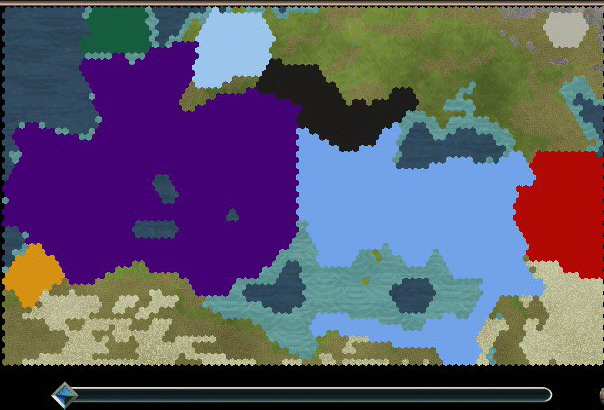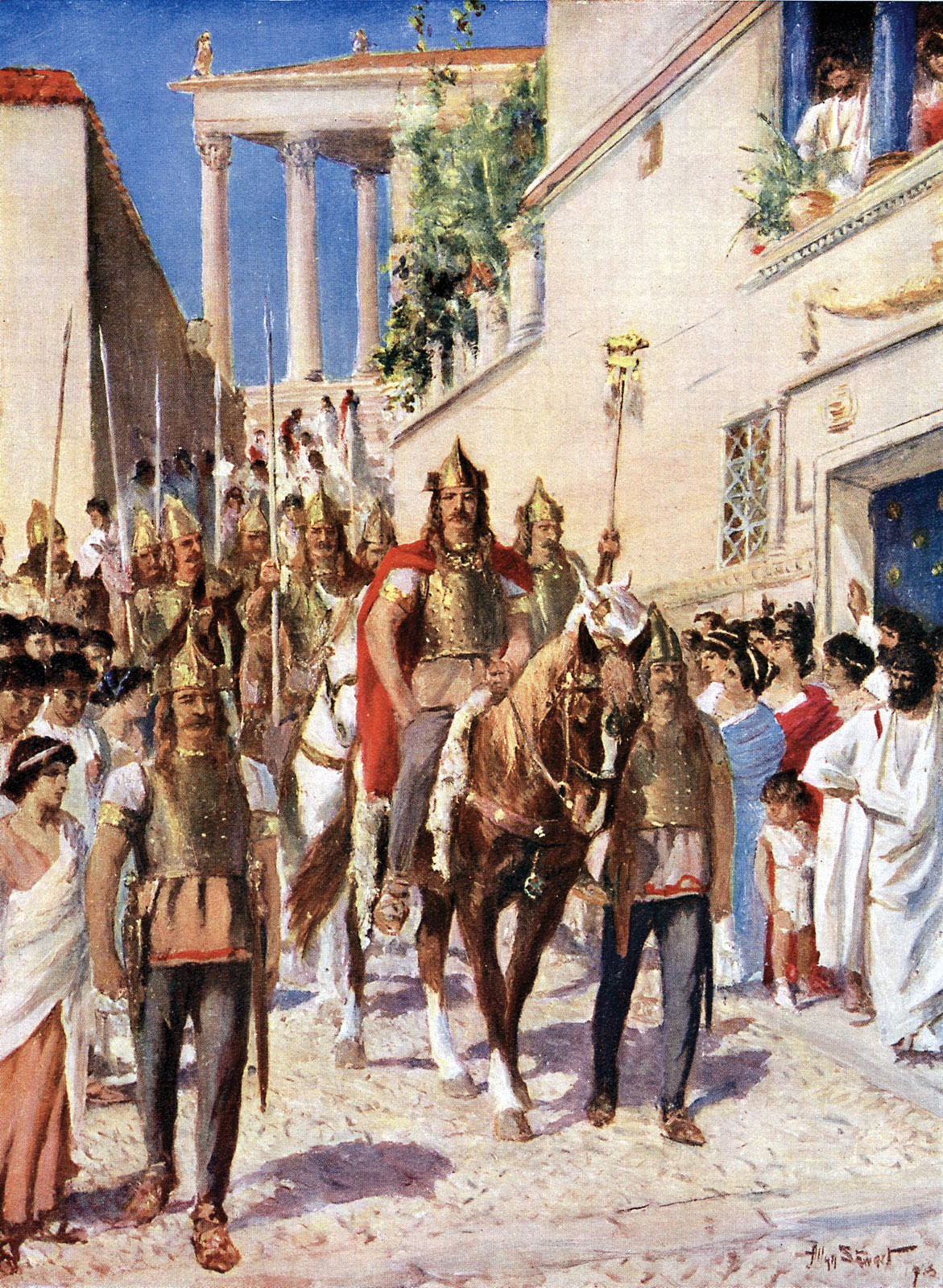My second Fall of Rome (Deity) guide gives you a quick walkthrough how to beat the scenario playing the Goths. The Goth strategy is very straightforward, since it’s basically a constant push and flow of new units that will drive the Goth advance into the heart of the Eastern Roman Empire. Years ago, when I started this blog, I had failed to beat the Fall of Rome scenario on Deity difficulty with any of the Western civilizations (Celts, Franks, Vandals, Goths, West-Rome). Now, having finished all other scenarios I revisited this one and succeeded where in 2013 (!) I had failed.
Fall of Rome – The Goths, Mysterious origin, rise, separation and fall of a people
In this scenario, especially when aiming at playing successfully, we’ll relive the struggles of the Goth people. Originating in Southeast Sweden, the Island of Gotland and later the Weichsel-area, the Goths grew stronger in numbers as they migrated South towards the Danube river.
Starting from their “long time” home region in present day Romania, the scenario begins with the five cities of Arheimar, Apulon, Turda, Tyras and Olbia.
From there we’ll follow the Goths historic route of their 3rd century raids on the (Eastern) Roman Empire: We’ll not only raid the Balkans and important cities at the Adriatic coast, but we’ll also visit Constantinople and Athens.

Through various twists of fate the Goths pretty much dominated the declining Roman Empire, but predominantly through Hunnic pressure, later split into two historic entities of which only one made it through the ages. They didn’t leave without making a mark though:
Alaric, whom we play in the Fall of Rome scenario, also sacked Rome in this world’s history. The later Visigoths (“Noble Goths”) made it to present day Spain and founded the Kingdom of Asturias, but succumbed to the Moorish armies. The Ostrogoths (“Eastern Goths”) couldn’t withstand the pressure by the Huns and became subject to their rule.
Failed attempts
| Apulon | Turda | Arkhmar | Tyras | Olbia |
| Catapult | C-Bow | C-Bow | Granary | Walls |
| Granary | Worker | Worker | Hov | Hov |
| Walls | Granary | Granary | Circus | |
| Gadrauht | Hov | Water Mill | Monument | |
| Water Mill | C-Bow | Monument | Stable | |
| Monument | Gadrauht | Colosseum | ||
| Circus | Hov | |||
| Gadrauht | ||||
In this first failed attempt I built both army and infrastructure and fully focused on Eastern Rome. I failed to see my weak spot: How open Apolon, but also Turda are to a Frankish attack. This first time I was completely steamrolled by them, putting up a brave defense, but losing eventually. Most importantly: I didn’t capture a single Roman city.
| Apulon | Turda | Arkhmar | Tyras | Olbia | Timeline |
| Monument | Monument | Monument | Monument | Monument | |
| Catapult | Catapult | Worker | Water Mill | Hov | |
| Hov | Hov | Water Mill | Circus | Walls | |
| Circus | Circus | Gadrauht | Hov | Circus | |
| Colosseum | Stable | Circus | Stable | ||
| Granary | |||||
| Hov | |||||
| Colosseum | |||||
| Units |



In this second (failed!) attempt, I turned the tables: I invaded the Franks myself! I took Cologne in turn 17 and marched on Duisburg, their capital. In the end I was too weak to take it while having wasted 30 of 70 turns of the entire scenario. There had to be another way.
Goth Deity – Strategy to defend against Franks and conquer Rome
Goths Deity – Build Order
Here’s the build order of the successful game in full, from start to almost finish. Just like with the Vandals, I tried saving the monuments for later in favor of different infrastructure and buildings early on, but that leaves you weak on the social policy side. So get those Monuments early.
| Apulon | Turda | Arheimar | Tyras | Olbia | Timeline |
| Monument | Monument | Monument | Monument | Monument | |
| Worker | Worker | Worker | |||
| Water Mill | Worker | Water Mill | Worker | ||
| Hov | Circus | ||||
| Walls | Hov | Water Mill | |||
| Circus | Colosseum | ||||
| Circus | Circus | ||||
| Gadrauht | Gadrauht | Gadrauht | |||
| Gadrauht | Gadrauht | Hov | |||
| Gadrauht | Gadrauht | Gadrauht | |||
| Gadrauht | Circus | ||||
| Hov | Amphitheater | Amphitheater | |||
| buy Amphitheater | Gadrauht | Turn 33 | |||
| Granary | Horseman | Granary | Granary | ||
| Horseman | Horseman | ||||
| Horseman | Horseman | Stable | |||
| Horseman | Colosseum | Stable | |||
| Stable | Catapult | Granary | Colosseum | Colosseum | |
| Colosseum | Barracks | Turn 48 | |||
| Horseman | Barracks | Walls | |||
| Horseman | Composite Bowman | Composite Bowman |
Goth Social Policies
The main driver for social policies is conquest of Roman cities. The culture yield from those is far higher than what culture-buildings can earn you over the course of 70 turns. My tip is to focus on the left Social policy tree, which is boosting your military:
- Willing Recruits (turn 11), +50% Production when training combat units
- Wily Veterans (turn 24), Military Units gain +100% Experience from combat
- Destiny’s Army (turn 39), +50% combat strength for military Units which have another military Unit in an adjacent tile
- Native Coercion (turn 55), build Courthouses 150% faster
- Tribal Bloom (turn 69), +5 Production in every City
- Kingdom Come (–), +2 Food, Production, Gold and Culture per City
Securing the Western Border against Rome and the Franks
Please also see the Fall of Rome Map for navigating and planning your conquest.
Somehow the Franks won’t destroy the Citadel in that very spot. This means all their units take tremendous damage, especially since they have to wait right next to it. For their initial onslaught plenty of Gadrauhts are necessary, but eventually a defense of 2-3 will suffice.
One essential point is building roads! You’ll need to connect your western provinces as quickly as possible. The connection I chose goes from Arheimar straight west, then directly to Turda. From where you turn, another worker needs to start building another road for Naissus immediately. This road will be important for units built in Apulon and Turda to head for the Balkans. From turn ~30 start building another road directly south from Arheimar towards Naissus/Adrianople. This will become your main road once the huge land army of Eastern Rome has been diminished.
Slow crawl against Eastern Rome’s Defense
Here’s my timeline: Unlike playing the Vandals there’s no big push at the end. Playing the Goths is a slow, but steady conquest with Constantinople as the crown jewel, the biggest single source of Victory Points pretty much at the end. And it’s urgently required, since without it “Team Rome” would have prevailed! Only the last recapture of Constantinople and Athens brought me the 11.000 Victory Points score leadership.
| Timeline of Conquest | Total VP |
| 05 – 400 VP Carnuntum (4) 18 – 600 VP Salonae (6) 26 – 600 VP Sirmium (6), razed 35 – 800 VP Naissus (8) 51 – 800 VP Dyrrachium (9) 54 – 1200 VP Thessalonica (12) 55 – 1200 VP Adrianople (13), burn down for some turns 62 – 1200 VP Nicopolis (12), burn down for some turns 67 – 1400 VP Athens (15), liberated by Eastern Rome 68 – 200 VP Athens (7) 68 – 2000 VP Constantinople (21), liberated again 69 – 400 VP Constantinople (5) 69 – 200 VP Athens (3) | 400 1000 1600 2400 3200 4400 5600 6800 8200 8400 10400 10800 11000 |
The Romans Army is massive and it’s resistance fierce. You see that while Naissus is weakly defended, the Romans cross the Danube river in high numbers. Two veteran Horsemen roaming the forests there plus 2-3 Gadrauhts fortified in the hills north of the river make for your defense. The moment Naissus falls, these troops will turn right for it. Use your defense to encircle them and eventually they’ll all perish.
While attacking Dyrrachium and any city close to the sea: Make sure to have many units at the coast or none at all. If you have a few: Dromon fire will focus on them and destroy them. But if there’s one unit in range of each Dromon, they won’t move, but all fire at their nearest unit, allowing you not only to survive, but to gain XP. First and foremost: Protect ranged units and sacrifice melees, then of course protect veterans and sacrifice rookies. For the coming battle of Constantinople you’ll need ranged Catapults and ranged Composite Bowmen:



At this point you’ll need to have enough troops to split them: The major share, most veterans march on Constantinople, but an attack force strong enough to make an impact will need to head south to take Nicopolis and Athens. Definitely take some Horsemen, since you’ll be able to capture cities without losing the attacking unit (Horsemen can leave the city after capturing it).
Long and costly battle of Constantinople






You’ve attacked cities before. Not much I’ll say about this battle, but a few tips:
- bring rookie bowmen from the rear to kill Dromons in the Black Sea and the Aegean Sea
- build one offensive Citadel to support your advance
- once the Sea of Marmara is clear – cross it to increase pressure and clear melee units behind Constantinople
- bring loads of workers to build roads for movement and forts for defense
Winning Fall of Rome: Goths






Conclusion:
Whew. Unlike playing the Vandals, the Goths on this level of difficulty never develop such strong military dominance. Even though we conquered the Balkans, the Seas still belong to Rome. And from there they rain fire down on us. The slow drag towards the end is painful, the suspense whether the score will be enough is intense. It’s been quite a relief making this eventually. Over all still another 3h 44min good fun playing Civilization 5.

🙂


















